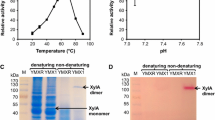Abstract
Objectives
To genetically engineer Saccharomyces cerevisiae for improved ethanol productivity from glucose/xylose mixtures.
Results
An endogenous gene cassette composed of aldose reductase (GRE3), sorbitol dehydrogenase (SOR1) and xylulose kinase (XKS1) with a PGK1 promoter and a terminator was introduced into two S. cerevisiae strains, a laboratory strain (CEN.PK2-1C) and an industrial strain (Kyokai No. 7). The engineered Kyokai No. 7 strain (K7-XYL) exhibited a higher sugar consumption rate (1.03 g l−1 h−1) and ethanol yield (63.8 %) from a glucose and xylose mixture compared to the engineered CEN.PK2-1C strain. Furthermore, K7-XYL produced a larger amount of ethanol (39.6 g l−1) compared to K7-SsXYL (32 g l−1) with integrated xylose reductase and xylitol dehydrogenase from a xylose-assimilating yeast Scheffersomyces stipitis instead of GRE3 and SOR1.
Conclusion
The created S. cerevisiae strain showed sufficient xylose-fermenting ability to be used for efficient ethanol production from glucose/xylose.




Similar content being viewed by others
References
Gonçalves DL, Matsushika A, de Sales BB, Goshima T, Bon EPS, Stambuk BU (2014) Xylose and xylose/glucose co-fermentation by recombinant Saccharomyces cerevisiae strains expressing individual hexose transporters. Enzym Microb Technol 63:13–20
Ho NW, Chen Z, Brainard AP (1998) Genetically engineered Saccharomyces yeast capable of effective cofermentation of glucose and xylose. Appl Environ Microbiol 64:1852–1859
Ito H, Fukuda Y, Murata K, Kimura A (1983) Transformation of intact yeast cells treated with alkali cations. J Bacteriol 153:163–168
Karhumaa K, Fromanger R, Hahn-Hägerdal B, Gorwa-Grauslund MF (2007a) High activity of xylose reductase and xylitol dehydrogenase improves xylose fermentation by recombinant Saccharomyces cerevisiae. Appl Microbiol Biotechnol 73:1039–1046
Karhumaa K, Sanchez RG, Hahn-Hägerdal B, Gorwa-Grauslund MF (2007b) Comparison of the xylose reductase-xylose dehydrogenase and the xylose isomerase pathways for xylose fermentation by recombinant Saccharomyces cerevisiae. Microb Cell Fact 6:5
Kötter P, Ciriacy M (1993) Xylose fermentation by Saccharomyces cerevisiae. Appl Microbiol Biotechnol 38:776–783
Limtong S, Sumpradit T, Kitpreechavanich V, Tuntirungkij M, Seki T, Yoshida T (2000) Effect of acetic acid on growth and ethanol fermentation of xylose fermenting yeast and Saccharomyces cerevisiae. Kasetsart J 34:64–73
Madhavan A, Tamalampudi S, Ushida K, Kanai D, Kitahara S, Srivastava A, Fukuda H, Bisaria VS, Kondo A (2009) Xylose isomerase from polycentric fungus Orpinomyces: gene sequencing, cloning and expression in Saccharomyces cerevisiae for bioconversion of xylose to ethanol. Appl Microbiol Biotechnol 82:1067–1078
Richard P, Toivari MH, Penttilä M (1999) Evidence that the gene YLR070c of Saccharomyces cerevisiae encodes a xylitol dehydrogenase. FEBS Lett 457:135–138
Sarthy AV, Schopp C, Idler KB (1994) Cloning and sequence determination of the gene encoding sorbitol dehydrogenase from Saccharomyces cerevisiae. Gene 140:121–126
Toivari MH, Salusjärvi L, Ruohonen L, Penttilä M (2004) Endogenous xylose pathway in Saccharomyces cerevisiae. Appl Environ Microbiol 70:3681–3686
Träff KL, Jönsson LJ, Hahn-Hägerdal B (2002) Putative xylose and arabinose reductases in Saccharomyces cerevisiae. Yeast 19:1233–1241
Urbanczyk H, Noguchi C, Wu H, Watanabe D, Akao T, Takagi H, Shimoi H (2011) Sake yeast strains have difficulty in entering a quiescent state after cell growth cessation. J Biosci Bioeng 112:44–48
Walfriedsson M, Bao X, Anderlund M, Lilius G, Bülow L, Hahn-Hägerdal B (1996) Ethanolic fermentation of xylose with Saccharomyces cerevisiae harboring the Thermus thermophilus xylA gene, which expresses an active xylose (glucose) isomerase. Appl Environ Microbiol 62:4184–4190
Author information
Authors and Affiliations
Corresponding author
Rights and permissions
About this article
Cite this article
Konishi, J., Fukuda, A., Mutaguchi, K. et al. Xylose fermentation by Saccharomyces cerevisiae using endogenous xylose-assimilating genes. Biotechnol Lett 37, 1623–1630 (2015). https://doi.org/10.1007/s10529-015-1840-2
Received:
Accepted:
Published:
Issue Date:
DOI: https://doi.org/10.1007/s10529-015-1840-2




